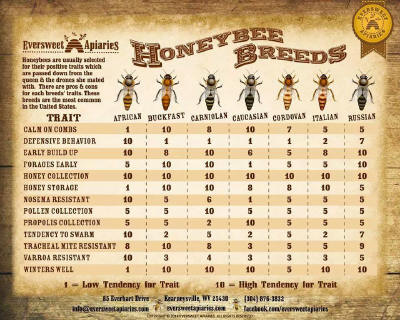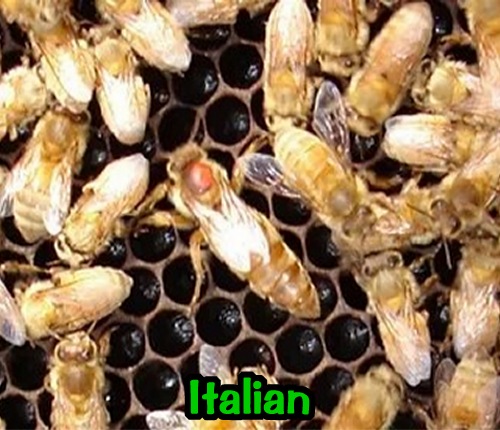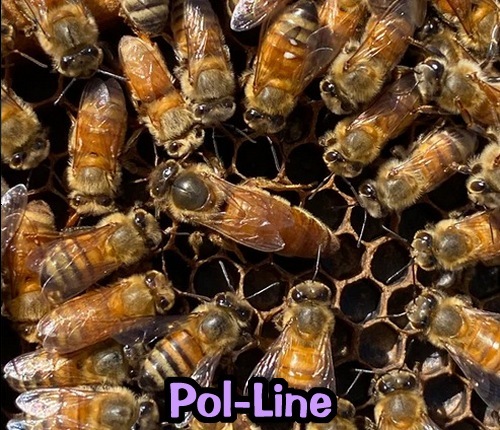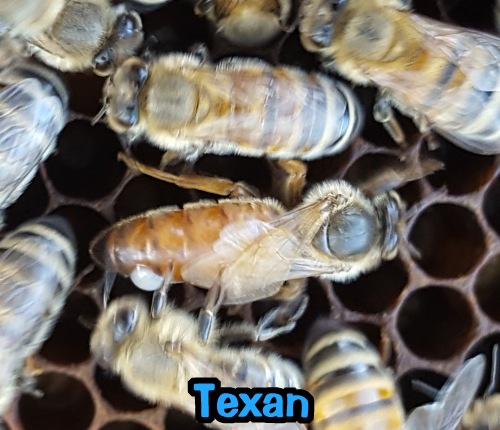As a way to identify and
converse about the many types of living things on our planet we give
everything a name. Years ago a scientist developed a naming system, called
taxonomy, as a way to catalogue the various forms of life around us. So
we now have common names as well as the scientific names of all biological
life. These fall into branches, or families, then subfamilies, tribes,
genus, species and subspecies.
Our beloved honey producing insects are from the Tribe Apini - or commonly
called Honey Bees.
Here at The Bee Place, we work with queen breeders from
various locations around the country, including Hawaii, to source the best
genetics available. This is both for our own apiaries as well as the bees we
offer for sale to the public. We have been very happy with the Italian lines
for their gentle behavior and production and the Pol-Lines for their
durability and fast build up in the spring, both are VSH lines and tested
for mite resistance as well as gentleness. Our Texan lines are also mite
resistant and, like the others we offer, are proven to do very well in our
area, but they are a bit more "spicy" - a trait that many people prefer. All
three of these are good bees and produce good honey and have shown to be
resistant to the Varroa Mites.
However, all of these lines bees are still exposed to the elements of nature
and are subject to have mites, so we test and treat accordingly as needed.
Failure to test and treat for mites with any genetic could result in colony
loss in less than a year.
A quick Google search (see image below) will produce a wide range and types
of bees - shown here for reference.

Within the Genus Apis we have the popular Species mellifera -
Apis.mellifera a.k.a. The Western Honey Bee
Others include, A.cerana, the Asian cousin and more as shown above.
While there are others, most beekeepers prefer the Western verities.
They fall into several subspecies:
- Subspecies ligustica - Italian
Honeybee
- Subspecies carnica - Carniolan
Honeybee
- Subspecies mellifera - Black
Honeybee
- Subspecies scutellata - African
Honeybee
- etc.
There are several different named
strains of bees from different parts of the world. Each evolving to adopt to
their surroundings over many years, therefore they are most suited to their
own environments. Some adapt well in other areas, some not so much. Extreme
temperature variations, for example, and other conditions make one race
favorable over another in different areas and parts of the world.
Here is a list of some of the more common and well known types:
Italian, German,
Carniolan, Buckfast, Caucasian, Russian and the infamous Africanized
Hybrid honey bee. There are numerous additional hybrid stocks currently
available with more being worked on constantly.
Since we understand that not everyone
has the same preferences, here at The Bee Place, we offer more than one type
or "race" of bees, when available. We are also aware of some of the reasons
that someone may chose one type of bee over another. For example, when
starting out in beekeeping the average person prefers to work with bees of
the most gentle and docile temperaments. For this reason, the Italian lines
are the most popular for first year beekeepers. As with most things, as more
education and experience is gained, with beekeeping, the more confident one
becomes handling bees and less intimidated by more defensive colonies.
So depending on where you are on the
road of your beekeeping adventure or who you ask, one type of bee may be
preferred over another. This graphic from the good folks at
Eversweet
Apiaries offers an overview of the different races and their traits
(note: not everyone agrees with this chart). An
internet search for "Different types of honey bees" will return this and
many more results offering a description with pros and cons for each race.
Please keep in mind that as with most things beekeeping, there are about as
many different opinions as there are beekeepers and not all are in
agreement. A particular trait, fast builders for example, is considered by
some to be a good trait (because they want their bees to build up fast in
the spring) and a bad trait by others because they may swarm if they are not
provided adequate growing room in a timely fashion. Or, the more defensive
the race, the more pest (mite and beetle) and predator resistant they are,
but they are not a race you can work without a good suit and gloves. So they
all have their pros and cons. It may be several seasons before you discover
which race is right for you and will perform best in your area. Or you may
enjoy a variety of bees in your apiary and experimenting with these
different traits.

(Click the image for a larger view)
|
|
VSH
Italian Queen with Bees
Recommended for Beginning Beekeepers
|
|
 |
A very gentle bee with high honey production, good
early build up, medium swarming rate, and will over winter well in our
area.
The traditional Italians are now tested for mite resistant considered
VSH lines. These bees do have a tendency to rob other colonies,
including their own kind.
More Here ...
Italian Bees |
| |
|
VSH Pol-Line Queen with Bees
Recommended for Beginning Beekeepers |
|
 |
The Pol-line breeding program was conceived and used by the USDA to move
VSH traits from the lab into bees that commercial beekeepers would want
to use. They were very successful with the program's results. "Pol-line"
initially named some of the early queens produced from the program.
Understanding that "Pol-line" actually names a selection and breeding
process that may be used to breed with any population of honey bees, is
important. Breeding stock that's the result of a program that uses
similar methodology as the Pol-line program will also have good results,
depending of course on the proficiency of the breeding, selection and
size of the population used. The takeaway is that the breeding method,
produces the strain.
More Here ... Pol-Line Bees |
| |
VSH Texan Queen with Bees
Mite Resistant - From Local Breeding Stock
|
|
 |
A mite resistant bee with
good honey production, steady early build up, low swarming rate, and
will over winter very well in our area.
The Texans are moderately defensive, more than
some of the other lines of bees, but not as aggressive as others, such
as the Russian lines.
More Here ... Texan
Bees |
|
